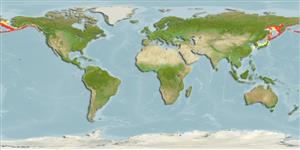Environment: milieu / climate zone / depth range / distribution range
Ecología
marino batidemersal; rango de profundidad 19 - 750 m (Ref. 50550). Deep-water
North Pacific: Sea of Japan to the Sea of Okhotsk and the Bering Sea.
Tamaño / Peso / Age
Maturity: Lm ? range ? - ? cm
Max length : 42.0 cm TL macho / no sexado; (Ref. 43939)
Short description
Claves de identificación | Morfología | Morfometría
Espinas dorsales (total) : 5 - 7; Radios blandos dorsales (total) : 6 - 8; Espinas anales: 0; Radios blandos anales: 7 - 9; Vértebra: 40 - 42. Snout round, without a barbel on its anterior tip; dorsum highly elevated at nape (Ref. 559). Branchial membranes united, free from isthmus (Ref. 559). Bony plate on body with a large sharp spine (Ref. 559).
Found over rocky gravel and muddy sand bottoms (Ref. 43939).
Life cycle and mating behavior
Madurez | Reproducción | Puesta | Huevos | Fecundidad | Larva
Mecklenburg, C.W., T.A. Mecklenburg and L.K. Thorsteinson, 2002. Fishes of Alaska. American Fisheries Society, Bethesda, Maryland. xxxvii +1037 p. (Ref. 43939)
IUCN Red List Status (Ref. 130435: Version 2024-2)
Threat to humans
Harmless
Human uses
Herramientas
Special reports
Download XML
Fuentes de Internet
Estimates based on models
Preferred temperature (Ref.
123201): 0.3 - 5.5, mean 1.8 °C (based on 368 cells).
Phylogenetic diversity index (Ref.
82804): PD
50 = 0.7500 [Uniqueness, from 0.5 = low to 2.0 = high].
Bayesian length-weight: a=0.00479 (0.00189 - 0.01213), b=3.05 (2.83 - 3.27), in cm total length, based on LWR estimates for this (Sub)family-body shape (Ref.
93245).
Nivel trófico (Ref.
69278): 3.1 ±0.2 se; based on diet studies.
Resiliencia (Ref.
120179): Bajo, población duplicada en un tiempo mínimo de 4.5-14 años (Preliminary K or Fecundity.).
Fishing Vulnerability (Ref.
59153): Low to moderate vulnerability (32 of 100).
